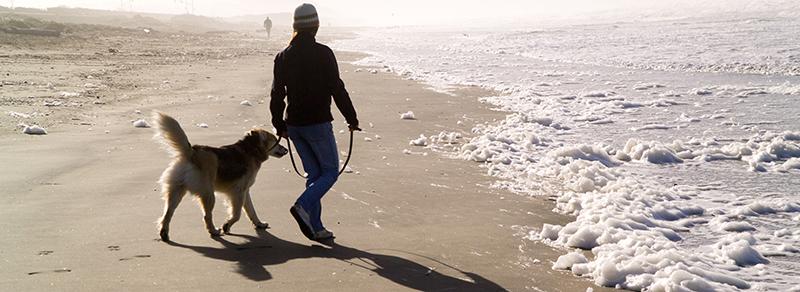
Nearly one-third of mileage on the beaches in Golden Gate National Recreation Area would be available for dog walking under the latest plan from the park/NPS
In a decision that quickly drew condemnation, officials at Golden Gate National Recreation Area in California have settled on a plan to manage dogs that provides for both off-leash and on-leash areas in the sprawling recreation area.
While acting General Superintendent Jim Milestone said that under the plan "(W)e will proudly remain the most dog-friendly park in the National Park System and the only one to offer off-leash dog recreation," some dog owners were unimpressed with the management plan that took years to arrive at.
“I think we started out with a highly restrictive plan for dog-walking years ago, and we’ve ended with a highly restrictive plan for dog-walking,” Christine Corwin, president of the Coastside Dog Owners Group of San Mateo County, told the East Bay Times. “They have conceded very little.”
On the group's website, the organization charged that, "(A)lthough the National Park Service is touting the plan as a compromise, it is far from a compromise. Right now, dog walking is only allowed on 1 percent of GGNRA lands. The Park Service's plan would cut current off-leash dog walking areas in GGNRA by 90 percent and on-leash areas by more than 50 percent.
"The Park Service estimates the dog management plan will cost $2.6 million per year to implement. There is widespread opposition to this plan in Marin, San Francisco, and San Mateo counties. During the last public comment period in spring 2016, people opposed the plan 3-to-1," the group said. "Unfortunately, the Park Service has failed to listen to the public. They are trying to push this highly-restrictive and expensive plan through before the Trump administration takes office in January. As such, the National Park Service said it will next enter their record of decision on January 10, 2017, which will be followed by the final rule."
For a list of impacts to dog owners under the management plan, visit the group's website.
Under the plan announced this past week:
- 22 locations were approved for dog walking at the recreation area, including sites at six locations that "would welcome dogs under voice and sight control (off-leash)."
- It identifies areas that would be dog-free. "Nearly one-third (31 percent) of the mileage on the park’s beaches and more than one-third (34 percent) of the mileage on trails would be available for dog walking. Specific park areas would allow walking 4-6 dogs with an NPS permit."
- Addition of voice and sight control (“off-leash”) area at Rancho Corral de Tierra (Flat Top).
- Addition of on-leash loop trail at Muir Beach (Kaashi Way).
- Expansion of both voice- and sight-control and dog-free areas at Crissy Field.
- Realignment and expansion of on-leash area at Baker Beach.
- Addition of an accessible on- and off-leash trail at Fort Funston.
- Addition of on-leash trail at Mori Point (Mori Headlands Trail).
- Addition of on-leash trail to overlook at Milagra Ridge (Milagra Ridge Road).
“The Dog Management Plan seeks to balance recreation and preservation at Golden Gate National Recreation Area, increase visitor safety by providing space for all types of recreational users, and protect park resources for future generations,” Acting Superintendent Milestone said in a release.
The National Park Service intends to publish its Record of Decision on the management plan in January, with a final rule to follow.
People long have taken their dogs to the lands now within the NRA to be walked and to let them run free. Over the years, though, there have been problems with dogs chasing and attacking wildlife, and bothering other visitors. And, too, there was a growing problem with dog feces, according to the Park Service.
The National Parks Conservation Association said the plan is a good compromise for dog owners and protection of wildlife.
“Out of all of our 413 national park sites, Golden Gate National Recreation Area is the only one to offer opportunities for people to walk their dogs off-leash. The park is also home to more threatened and endangered species than Yosemite, Yellowstone, and Sequoia-Kings Canyon national parks combined. It is essential that the park is managed and protected for the long term for all of us," Neal Desai, director of Pacific region field operations for NPCA, said in a release. "The Park Service struck this balance in its final plan, which generously includes even more opportunities for people to explore the park with their dogs, with new additions in San Mateo, San Francisco and Marin counties.
“With its common-sense zoning approach for the plan, visitors will continue to bring their dogs to enjoy the park’s beaches, trails, and areas of outstanding natural beauty. Rightfully, the final rule reduces dog-walking conflicts with other recreational activities and continues to protect wildlife-rich, fragile lands with dog-free areas."
In 2000, dog walkers sued the National Park Service for closing part of Fort Funston to the public. In the end, the judge ruled for the dog walkers, saying the Park Service had failed to obtain public input on the closure. That was the first legal exchange that eventually led the Park Service to develop a dog management plan for the entire NRA.



Add comment